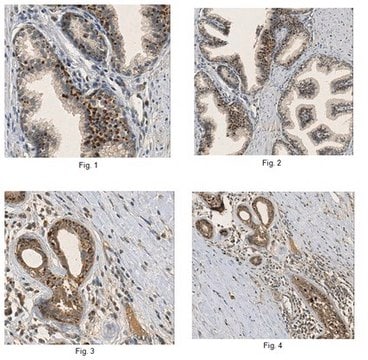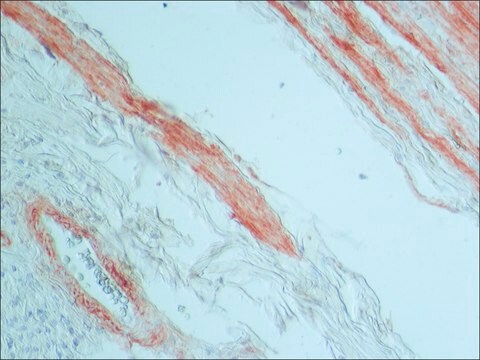ABS1593
Anti-sFRP-1 Antibody
from rabbit
Synonyme(s) :
Secreted frizzled-related protein 1, FRP-1, SARP-2, Secreted apoptosis-related protein 2, sFRP-1
About This Item
Produits recommandés
Source biologique
rabbit
Niveau de qualité
Forme d'anticorps
purified antibody
Type de produit anticorps
primary antibodies
Clone
polyclonal
Espèces réactives
human, mouse
Technique(s)
immunohistochemistry: suitable
neutralization: suitable
western blot: suitable
Numéro d'accès NCBI
Numéro d'accès UniProt
Conditions d'expédition
ambient
Modification post-traductionnelle de la cible
unmodified
Informations sur le gène
human ... SFRP1(6422)
Description générale
Spécificité
Immunogène
Application
Neutralizing Analysis: A representative lot, in combination with recombinant Wtn5a and an anti-DKK1 antibody, increased migration and mammosphere formation of EpCAM-positive (EPC+) human mammary epithelial cells (MECs) (Scheel, C., et al. (2011). Cell. 145(6):926 940).
Neutralizing Analysis: A representative lot enhanced the formation of TRACP+ mutinucleated and mononucleated cells from co-cultured murine splenic and primary osteoblastic cells upon PGE2 and 1 ,25 (OH)2D3 stimulatation (Häusler, K.D., et al. (2004). J. Bone Miner. Res. 19(11):1873-1881).
Note: Detection of endogenous sFRP-1 in whole cell lysates or tissue samples is difficult without an enrichment step prior to immunoblotting (e.g. by immunoprecipitation or heparin affinity chromatography).
Signaling
Qualité
Western Blotting Analysis: 1 µg/mL of this antibody detected in 10 ng of mammalian expressed, secreted human sFRP-1.
Description de la cible
Forme physique
Stockage et stabilité
Handling Recommendations: Upon receipt and prior to removing the cap, centrifuge the vial and gently mix the solution. Aliquot into microcentrifuge tubes and store at -20°C. Avoid repeated freeze/thaw cycles, which may damage IgG and affect product performance.
Autres remarques
Clause de non-responsabilité
Not finding the right product?
Try our Outil de sélection de produits.
Code de la classe de stockage
12 - Non Combustible Liquids
Classe de danger pour l'eau (WGK)
WGK 2
Point d'éclair (°F)
Not applicable
Point d'éclair (°C)
Not applicable
Certificats d'analyse (COA)
Recherchez un Certificats d'analyse (COA) en saisissant le numéro de lot du produit. Les numéros de lot figurent sur l'étiquette du produit après les mots "Lot" ou "Batch".
Déjà en possession de ce produit ?
Retrouvez la documentation relative aux produits que vous avez récemment achetés dans la Bibliothèque de documents.
Notre équipe de scientifiques dispose d'une expérience dans tous les secteurs de la recherche, notamment en sciences de la vie, science des matériaux, synthèse chimique, chromatographie, analyse et dans de nombreux autres domaines..
Contacter notre Service technique







